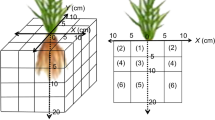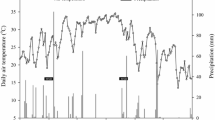Abstract
Background and aims
Studies have found significant differences in methane (CH4) emissions among rice cultivars; however, it is unclear whether this difference is related to radial oxygen loss (ROL) from the roots.
Methods
Based on a 2-year in situ field study and solution culture experiments on 16 rice cultivars, we investigated CH4 emission levels and their dependence on ROL.
Results
We detected significant differences in CH4 emission and ROL among rice cultivars. The lowest and highest CH4 emission levels were 4.10 and 7.35 g m−2 for early rice, and 14.36 and 23.33 g m−2 for late rice, respectively. The maximum and minimum ROL values were 3.77 and 1.73 mmol plant−1 h−1 for early rice, and 4.18 and 2.08 mmol plant−1 h−1 for late rice, respectively. Seasonal total CH4 emission was negatively correlated with ROL in the early rice season (p < 0.01), and (p < 0.01) in the late rice season. ROL was positively correlated with the number of roots per plant (RN), root tips per plant (RT), and root volume per plant (RV).
Conclusions
We suggest that ROL can be used as a predictive index for CH4 emissions. RN, RT, and RV were the most important factors influencing ROL in rice cultivars.



Similar content being viewed by others
References
Armstrong W (1978) Root aeration in the wetland condition in: hook, DE, Crawford, RMM (Eds). Plant Life in Anaerobic Environment Ann Arbor Science Publisher, Ann Arbor, MI, USA, pp 267–297
Blossfeld S, Gansert D, Thiele B et al (2011) The dynamics of oxygen concentration, pH value, and organic acids in the rhizosphere of Juncus spp. Soil Biol Biochem 43:1186–1197
Bridgham SD, Cadillo-Quiroz H, Keller JK et al (2013) Methane emissions from wetlands: biogeochemical, microbial, and modeling perspectives from local to global scales. Glob Chang Biol 19:1325–1346
Butterbach-bahl K, Papen H, Rennenberg H (1997) Impact of gas transport through rice cultivars on methane emission from rice paddy fields. Plant Cell Environ 20:1175–1183
Connell EL, Colmer TD, Walker DI (1999) Radial oxygen loss from intact roots of Halophila ovalis as a function of distance behind the root tip and shoot illumination. Aquat Bot 63:219–228
van der Gon N (1996) Oxidation of methane in the rhizosphere of rice plants. Biol Fertil Soils 22:359–366
Fu ZQ, Huang H, He BL et al (2009) Correlation between rice plant aerenchyma system and methane emission from paddy field. Acta Agron Sin 33:1458–1467 (in Chinese)
van Groenigen KJ, van Kessel C, Hungate BA (2013) Increased greenhouse-gas intensity of rice production under future atmospheric conditions. Nat Clim Chang 3:288–291
Gutierrez J, Kim SY, Kim PJ (2013) Effect of rice cultivar on CH4 emissions and productivity in Korean paddy soil. Field Crop Res 146:16–24
Khalil MAK, Shearer MJ, Rasmussen RA et al (2008) Methane and nitrous oxide emissions from subtropical rice agriculture in China. J Geophys Res 113(G3):1–6
Kludze HK, Delaune RD, Patrick WHJ (1993) Aerenchyma formation and methane and oxygen exchange in rice. Soil Sci Soc Am J 57:386–391
Lai WL, Zhang Y, Chen ZH (2012) Radial oxygen loss photosynthesis and nutrient removal of 35 wetland plants. Ecol Eng 39:24–30
Li YL, Fan XR, Shen QR (2008) The relationship between rhizosphere nitrification and nitrogen -use efficiency in rice plants. Plan, Cell and Environment 31:73–85
Liu CW, Wu CY (2004) Evaluation of methane emissions from Taiwanese paddies. Sci Total Environ 333:195–207
Liu YX, Yang M, Wu YM et al (2011) Reducing CH4 and CO2 emissions from waterlogged paddy soil with biochar. J Soils Sediments 11:930–939
Mei XQ, Ye ZH, Wong MH (2009) The relationship of root porosity and radial oxygen loss on arsenic tolerance and uptake in rice grains and straw. Environ Pollut 157:2550–2555
Mei XQ, Wong MH, Yang Y (2012) The effects of radial oxygen loss on arsenic tolerance and uptake in rice and on its rhizosphere. Environ Pollut 165:109–117
Minami K, Neue HU (1994) Rice paddies as a methane source. Clim Chang 27:13–26
Mitra S, Jain MC, Kumar S et al (1999) Effect of rice cultivars on methane emission. Agric Ecosyst Environ 73:177–183
Parashar DC, Gupta PK, Rai J et al (1993) Effect of soil temperature on methane emission from paddy fields. Chemosphere 26:247–250
Setyanto P, Makarim AK, Fagi AM (2000) Crop management affecting methane emissions from irrigated and rain-fed rice in central java (Indonesia). Nutr Cycl Agroecosyst 58:85–93
Sorrell BK, Brix H (2003) Effects of water vapour pressure deficit and stomatal conductance on photosynthesis internal pressurization and convective flow in three emergent wetland plants. Plant Soil 253:71–79
Tanaka N, Yutani K, Aye T et al (2007) Effect of broken dead culms of phragmites australis on radial oxygen loss in relation to radiation and temperature. Hydrobiologia 583:165–172
Wang QA, Lu CM, Zhang QD (2005) Middy photoinhibition of two newly developed super rice hybrid. Photosynthetica 43:277–281
Wang MY, Chen AK, Wong MH et al (2011) Cadmium accumulation in and tolerance of rice (Oryza sativa L) varieties with different rates of radial oxygen loss. Environ Pollut 159:1730–1736
Wassmann R, Aulakh MS (2000) The role of rice plants in regulating mechanisms of methane emissions. Biol Fertil Soils 31:20–29
Watanabe A, Kajiwara M, Tashiro T et al (1995) Influence of rice cultivar on methane emission from paddy fields. Plant Soil 176:51–56
Xu H, Cai ZC, Jia ZJ (2002) Effect of soil water contents in the non-rice growth season on CH4 emission during the following rice-growing period. Nutr Cycl Agroecosyst 64:101–110
Yan XJ, Wang LL, Jiang Y (2013) CH4 emission features of leading super-rice varieties and their relationships with the varieties growth characteristics in Yangtze Delta of China. Chin J Appl Ecol 24:2518–2524 (in Chinese)
Yang JC (2012) Relationships of rice root morphology and physiology with the formation of grain yield and quality and the nutrient absorption and utilization. Sci Agric Sin 44:36–46 (in Chinese)
Yang CM, Yang LZ, Yang YX (2004) Rice root growth and nutrient uptake as influenced by organic manure in continuously and alternately flooded paddy soils. Agric Water Manag 70:67–81
Yang X, Shang Q, Wu P et al (2010) Methane emissions from double rice agriculture under long-term fertilizing systems in Hunan, China. Agric Ecosyst Environ 137:308–316
Yang JX, Liu Y, Ye ZH (2012) Root-induced changes of pH, eh, Fe(II) and fractions of Pb and Zn in rhizosphere soils of four wetland plants with different radial oxygen losses. Pedosphere 22:518–527
Zhu LF, Liu X, Yu SM (2010) Effects of aerated irrigation on physiological characteristics and senescence at late growth stage of rice. Chinese J of Rice Sci 24:257–263 (in Chinese)
Zou JW, Huang Y, Jiang JY (2005) A 3-year field measurement of methane and nitrous oxide emissions from rice paddies in China: effects of water regime crop residue and fertilizer application. Glob Biogeochem Cycles 19:GB2021
Acknowledgments
We thank the anonymous reviewers and editors for their helpful comments and suggestions. This work was supported by the National Natural Science Foundation of China (grant no. 41571293), the National Key Technology R & D Program (grant no. 2013BAD11B02), and the Earmarked Fund for China Agriculture Research System (grant no. CARS-01-26).
Author information
Authors and Affiliations
Corresponding author
Additional information
Responsible Editor: Paul Bodelier.
Electronic supplementary material
ESM 1
(DOCX 38 kb)
Rights and permissions
About this article
Cite this article
Zheng, H., Fu, Z., Zhong, J. et al. Low methane emission in rice cultivars with high radial oxygen loss. Plant Soil 431, 119–128 (2018). https://doi.org/10.1007/s11104-018-3747-x
Received:
Accepted:
Published:
Issue Date:
DOI: https://doi.org/10.1007/s11104-018-3747-x




